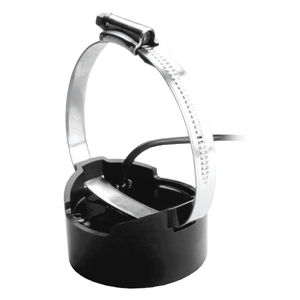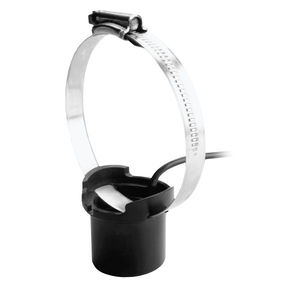
Depth transducer P79acousticfor boatfishfinder
Add to favorites
Compare this product
fo_shop_gate_exact_title
Characteristics
- Measured value
- depth, acoustic
- Application domain
- for boat
- Applications
- fishfinder
- Other characteristics
- ultrasonic
Description
Our P79 is a dual-frequency, depth only, in-hull transducer that easily adjusts to hull deadrise angles up to 22°.The P79 includes a plastic mounting base which is aligned to the centerline and secured inside the hull. Then it is filled with nontoxic antifreeze. The transducer is inserted into the base and adjusted for the proper deadrise offset, insuring the beam is shooting straight down for maximum echo returns. The coolant provides the best medium to transmit through the solid fiberglass and into the surrounding water. The major benefit of in-hull transducers is no protruding features on the exterior of the hull, making it the perfect choice for trailered or lifted boats. Designed for smaller boats up to 8 m (25') with a solid fiberglass hull.
Features:
Depth only
600 W
Dual-frequency element:
-50 kHz with a 45° beamwidth for depth performance to 294 m (1,000')
-200 kHz with an 12° beamwidth for depth performance to 180 m (600')
Adjusts to hull deadrise angles up to 22°
Drill-free installation
Recommended for planing-hull powerboats, trailered boats, rigid inflatable boats (RIBS), and racing sailboats
No hull protrusions
Urethane transducer housing with adjustable, plastic, mounting base
Optional 200 kHz only model available
Installed with a hand-adjustable base. No cutting is needed.
Specifications:
Weight: 2.3 kg (5 lb.)
Recommended Boat Length: Up to 8 m (25')
Hull Material: Solid fiberglass only
Hull Deadrise: Up to 22°
Acoustic Window: Layered plastic urethane
Includes: Adjustable mounting base
Catalogs
P79 Traditional
2 Pages
P39S P79S Smart Sensors
2 Pages
Exhibitions
Meet this supplier at the following exhibition(s):


Related Searches
- AIRMAR boat sensor
- AIRMAR temperature sensor
- AIRMAR depth transducer
- AIRMAR ultrasonic sensor
- AIRMAR acoustic sensor
- AIRMAR fishfinder sensor
- AIRMAR water temperature sensor
- AIRMAR through-hull transducer
- AIRMAR CHIRP sensor
- AIRMAR NMEA 2000® sensor
- Sailboat sensor
- Meteorological station
- Wireless sensor
- Acoustic transducer
- Boat acoustic transducer
- Network gateway
- Angle sensor
- Pitch sensor
- AIRMAR NMEA 0183® sensor
- Bluetooth sensor
*Prices are pre-tax. They exclude delivery charges and customs duties and do not include additional charges for installation or activation options. Prices are indicative only and may vary by country, with changes to the cost of raw materials and exchange rates.






